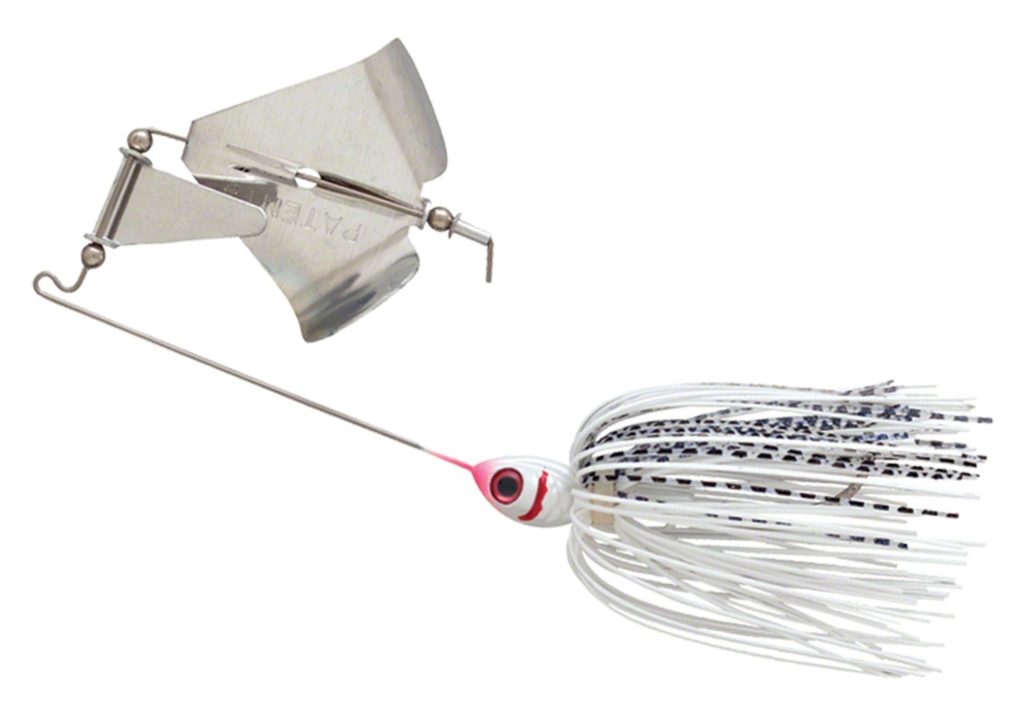Fishing a buzzbait just might be the most exciting style of bass fishing there is. They are one of the best topwater lures you can tie on, and any bass fisherman will agree that there is nothing like seeing a bass explode on a topwater lure. But especially a buzzbait, these are fast moving baits so the explosions tend to be bigger and more aggressive.
Similar to the framework of a spinnerbait, a buzzbait is a bent wire where one end is molded into a jig head. The jig head is dressed with a rubber skirt and the line is tied where the wire bends. The other end of the wire has a propellor attached that gives the bait lift and keeps it on the surface.
What sets a buzzbait apart from most other topwater lures is that it sinks. To keep a buzzbait on the surface it needs to be in constant motion, meaning once the bait hits the water you have to start reeling immediately and continuously reel until the bait is retrieved. They also create a unique sputtering noise that is hard for bass to ignore. In fact, a bass will often hit one just to shut it up.
Two newer buzzbaits that a lot of anglers are loving are the Swinging Sugar by Strike King and the Squelcher by Booyah. The swinging Sugar is a newer buzzbait design while the Squelcher is a classic buzzbait design but with a unique blade.
Contents
Types Of Buzzbaits
As a buzzbait is retrieved, the hook and skirt run just below the water surface, while the propellor cuts across the surface making a sputtering/gurgling sound and surface disruption that entices bass to bite. Buzzbaits come in all different styles, sizes, and colors, but their function is primarily the same.
Although buzzbaits have the same functionality for the most part, there are different styles and features to consider when determining the best buzzbait for the conditions you’re fishing.
Where buzzbait styles differ is in the amount of noise they put out, the speed at which they travel, and the amount of surface disruption they cause. Certain conditions can call for certain lure action, and adapting to the conditions with different style buzzbaits can be the difference between getting bites and getting skunked.
Let’s take a look at some of the most common types, click on any of the images to see their prices.
Single Prop Non-Clacker
This is the most basic buzzbait design there is. Like it’s name describes, a single prop non-clacker buzzbait is equipped with a single propellor and no clacker. Although basic, sometimes this buzzbait style can be the one that bass want most.
There are times when a buzzbait making too much noise can actually work against you. This is especially true during calm conditions, when sound travels a lot further underwater. This is a good style buzzbait to start off with when you’re trying to zero in on what bass are looking for on a particular day of fishing.
Single Prop Clacker

Over the years, lure designers began tweaking buzzbaits and that’s when the clacker came in to play. A clacker is a small metal piece that hangs on a hinge over the propellor, so as the prop spins the clacker hits the prop making a “clacking” noise. Think of it as like putting in a baseball card in your bike tire spokes.
Single prop clackers are the loudest buzzbaits out there. There are going to be times when this additional noise is the key to getting bass to strike. These are often the best choice in rougher conditions, when sound isn’t traveling a well under water.
Double Prop

These buzzbaits have two propellors that run parallel along side one another. The biggest advantage of a double prop buzzbait is how slow you can run them. Having two blades spinning gives the bait twice the resistance in the water as a single bladed bait. It also creates twice the sound and surface distruption.
The other advantage advantage is how straight these baits run. In general buzzbaits need to be tuned periodically to keep them running right straight and true, but the double prop is always balanced for the most part.
Fishing Buzzbaits
One of the biggest advantages buzzbaits have over other topwater lures is how much water you can quickly cover with them. These fast moving baits allow you to stay on the move when you’re trying to locate fish and put together a pattern. You can stop on an area and fan cast to just about every spot in a short amount of time, then continue on your pursuit if nothing bites.
Although these are fast moving baits, ironically the most effective way to fish them is as slow you possibly can. But even at their slowest speeds they will still move faster than any other lure. The key is to reel as slow and steady as you can while still keeping the bait up on the surface. Once you hit that optimal speed try to keep it consistent for the entire retrieve.
Another huge key to fishing a buzzbait is making long casts, so you need to make sure you are using the right rod for launching these baits. After making a long cast, you want to start reeling and get it up on the surface the second it hits the water. More often than not, a buzzbait is going to get hit within the first few seconds after it has landed, so you want the bait to start performing as soon as possible.
Best Buzzbait Conditions
Like with most topwater lures, the optimal time for fishing a buzzbait is in low light conditions, and ideally with a light chop on the water’s surface. Of course buzzbaits have the ability to produce anytime, but if those two conditions combine then you can be in for some crazy buzzbait action.
Buzzbaits excel when they’re being fished tight to cover. Running a buzzbait along a boat dock, lay down, or grass line are a couple examples of prime buzzbait strike zones. And they are fairly weedless, so don’t be shy about tossing them in and around vegetation.
You should also be trying to bump them against cover as much as you can. We talk about the importance of slow and steady retrieves, but breaking a retrieve up with a single quick bump off an object can trigger a massive strike. Fishing a buzzbait in a heavily wooded area can be heaven because it gives you the opportunity to bump the timber. Bumping a buzzbait against timber or rolling one up and over a log can result in a big bite.
The other time that buzzbaits truly excel is at night. In fact, a lot of bass fisherman will say it’s the only time for throwing buzzbaits. Topwater fishing in general is tremendous at night, and buzzbaits are certainly no exception to the rule. Running a buzzbait in the shallows on a calm summer night can catch you the fish of a lifetime.
That’s the crazy thing about buzzbaits, for some reason they often produce big fish. Much like a jig, there is just something about them that big bass love. And even though a buzzbait is a relatively simple lure to fish, casting accuracy plays a big role in your success. Getting the bait to land in the right areas and run tight to cover takes some good casting skills.
The biggest downside to fishing buzzbaits is they are often missed by bass. This is common for all topwater lures but especially buzzbaits because they move so quickly and only have one hook. That’s why it helps to retrieve the lure at the minimum speed required to propel the prop, it makes the lure an easier target.
If a bass misses a buzzbait, there’s about a one percent chance that bass will strike it again on a follow up cast. However, following up with something different has a very high success rate. Try casting a slow moving bait like a rubber worm or jig in the area where the buzzbait was missed. That bass is way more likely to go after the slow moving bait than the buzzbait again, so always keep something rigged up for for these occasions.
Another solution to missed strikes is adding a trailer hook to the back of the buzzbait. The trailer hook is designed to catch fish that strike just short of the bait. Because buzzbaits are so often missed, these are very popular amongst buzzbait fisherman.



